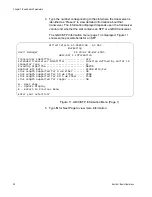
AT-S63 Management Software Menus User’s Guide
Section I: Basic Operations
47
Configuring the Telnet Server
This procedure describes how to enable and disable the Telnet server on
the switch. You might disable the server to prevent individuals from
managing the switch with a Telnet application or if you intend to use the
Secure Shell (SSH) protocol.
This procedure also explains how to toggle the Telnet server on the switch
so that is adds a NULL character after each CR. Some Telnet clients
require the character in order to correctly display the information from the
Telnet server.
To enable or disable the Telnet server or to set the Telnet NULL character
parameter, perform the following procedure:
1. From the Main Menu, type
5
to select System Administration.
The System Administration menu is shown in Figure 1 on page 32.
2. From the System Administration menu, type
3
to select Console
(Serial/Telnet) Configuration.
The Console (Serial/Telnet) Configuration menu is shown in Figure 7
on page 45.
3. To enable or disable the Telnet server, from the Console (Serial/
Telnet) Configuration menu type
4
to toggle Telnet Server between
Enabled and Disabled. The default is enabled.
Note
Disable Telnet access if you are using the SSH (Secure Shell)
feature. (The SSH feature is not available in all versions of the
AT-S63 Management Software.)
4. To configure the Telnet NULL character parameter, type
5
to toggle
Telnet insert NULL between On and Off. When Off, the default setting,
the Telnet server does not send a NULL character after each CR.
When On, the server does send the character.
A change to the status of the Telnet server or the Telnet NULL
character parameter is immediately implemented on the switch.
5. After making changes, type
R
until you return to the Main Menu. Then
type
S
to select Save Configuration Changes.
Summary of Contents for AT-9400
Page 16: ...Figures 16 ...
Page 18: ...Tables 18 ...
Page 28: ...Preface 28 ...
Page 30: ...30 Section I Basic Operations ...
Page 60: ...Chapter 1 Basic Switch Parameters 60 Section I Basic Operations ...
Page 64: ...Chapter 2 Port Parameters 64 Section I Basic Operations Port Type The port type ...
Page 84: ...Chapter 2 Port Parameters 84 Section I Basic Operations ...
Page 124: ...Chapter 6 Static Port Trunks 124 Section I Basic Operations ...
Page 144: ...144 Section II Advanced Operations ...
Page 196: ...Chapter 10 File Downloads and Uploads 196 Section II Advanced Operations ...
Page 218: ...Chapter 11 Event Logs and the Syslog Client 218 Section II Advanced Operations ...
Page 242: ...Chapter 13 Access Control Lists 242 Section II Advanced Operations ...
Page 294: ...294 Section III IGMP Snooping MLD Snooping and RRP Snooping ...
Page 314: ...Chapter 19 MLD Snooping 314 Section III IGMP Snooping MLD Snooping and RRP Snooping ...
Page 318: ...318 Section IV SNMPv3 ...
Page 416: ...Chapter 21 SNMPv3 416 Section IV SNMPv3 ...
Page 418: ...418 Section V Spanning Tree Protocols ...
Page 470: ...470 Section VI Virtual LANs ...
Page 520: ...Chapter 26 Multiple VLAN Modes 520 Section VI Virtual LANs ...
Page 532: ...Chapter 27 Protected Ports VLANs 532 Section VI Virtual LANs ...
Page 546: ...546 Section VII Internet Protocol Routing ...
Page 560: ...560 Section VIII Port Security ...
Page 568: ...Chapter 30 MAC Address based Port Security 568 Section VIII Port Security ...
Page 586: ...Chapter 31 802 1x Port based Network Access Control 586 Section VIII Port Security ...
Page 588: ...588 Section IX Management Security ...
Page 610: ...Chapter 33 Encryption Keys 610 Section IX Management Security ...
Page 650: ...Chapter 36 TACACS and RADIUS Protocols 650 Section IX Management Security ...
Page 660: ...Chapter 37 Management Access Control List 660 Section IX Management Security ...
Page 668: ...Index 668 ...






























